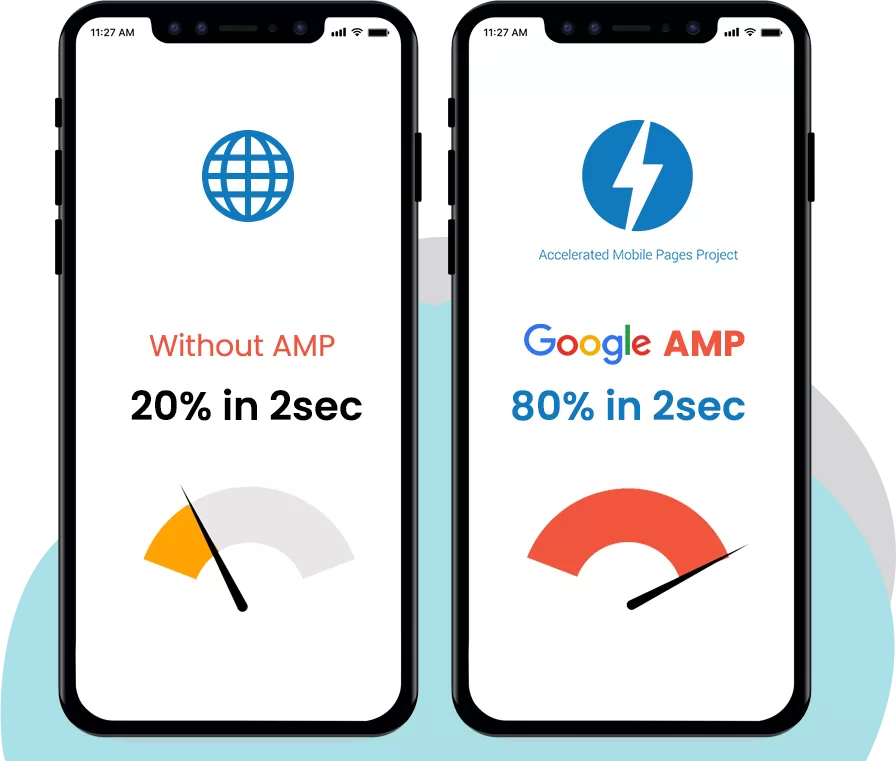What is AMP and what is it for?
AMP stands for Accelerated Mobile Pages. The term defines sites whose pages are optimized to load ina simpler and faster way when accessed from mobile devices, such as tablets and smartphones.
It is an initiative launched in 2015 and led by Google, in alliance with other technology companies, such as Twitter, LinkedIn and Pinterest. The project is based on open-source platforms and aims to improve the display of content for mobile browsing, making pages load faster and with lower data consumption.
On the search results page on a mobile device, AMP pages are identified with a seal and highlighted by Google, placing them above organic search results.
How does AMP work?
Now that you know what AMP is, it’s time to understand how it works. In general, the loading speed of any page depends on the number and size of files you have. As we mentioned, the main goal of the AMP structure on a website is to reduce the size of a page, making it lighter.
To make this happen, the user who clicks on a link on an optimized page is directed to a version with a simpler appearance and navigation than the original, but with the same content. The idea is to remove any element from the page that slows down the load.
To further streamline the process, AMP has a JavaScript library and an HTML tag, which are used to create an accelerated page. In addition, it also offers caching on Google’s servers, which allows the page to be viewed more quickly if accessed again.
Key Benefits of AMP Pages
Knowing what AMP is and how the feature works is important, but we also need to know its benefits. Check out the top three benefits of AMP pages:

improve user experience
Anyone who works with digital marketing and sales knows the importance of having a responsive website that loads quickly. After all, when a page takes too long to load or has issues immediately after loading, there’s a good chance that a user will leave the site and look for another address that provides a more streamlined experience.
To give you an idea, according to Google, 53% of mobile website visitors abandon the page if it doesn’t load within 3 seconds.
And that can become a big problem, as Google wants sites to provide a quality user experience and punish slower pages in search results. In addition, very slow pages can receive an alert flag for this problem, keeping potential visitors away.
In this sense, Google itself claims that AMP pages load 85% faster than their non-optimized versions, in addition to consuming 10 times less data to load completely.
Better SEO performance
Google does not reveal all the points it evaluates to position a site in the results pages of a search, but it is known that the loading speed and the time the user stays on the page directly influence its positioning.
As we’ve seen, AMP pages load much faster, which tends to drastically reduce user abandonment. In addition, by presenting a simplified version, it hardly leads to errors, making the visitor experience more fluid and, consequently, increasing their permanence.
However, for this to be effective, some care is needed. An AMP page is nothing more than a copy of the original URL, plus an /amp at the end of the email address. That is, a second URL is created and the content is duplicated, which is frowned upon by search engines and can hurt SEO.
To fix this issue, it is necessary to report that it is only an AMP version of the original URL. This can be done by including a canonical tag in the AMP page version and markup in the original page code.
Example: <link rel=”amphtml” href=”https://alohaxsystem.com/article/amp/”>
Finally, another factor that influences SEO is the fact that AMP pages are, in essence, mobile-friendly, i.e. optimized for mobile devices. This is a fact increasingly considered by Google for page ranking, as the company has adopted the “Mobile First” mentality.
Increased visibility
As we mentioned, AMP pages are identified in search results with an icon. This markup helps increase the volume of clicks and drive more traffic to the site. In addition, these pages are more likely to appear prominently in carousel results, which are the pages with images that appear just above organic mobile search results.
But is it worth investing in AMP?
Now that you know what AMP is and know its advantages, the question remains: is this strategy worth investing in?
Well, after having seen all this, we can conclude that page loading speed greatly influences the SEO of sites. Thus, adopting this type of optimization contributes to a more positive experience for customers and, consequently, generates more sales. If you want to apply this feature to your website and don’t know how to get started, don’t hesitate to contact us.
What is AMP on a Website and How It Improves Loading Speed?
In the context of modern web development, it’s critical to understand the concept of AMP, which stands for Accelerated Mobile Pages. This framework was initially created by Google with the aim of optimizing the loading speed of web pages on mobile devices.
AMP is based on a number of practices and technologies that ensure pages load quickly and efficiently. Here are some key aspects of how AMP works and its impact on web performance:
Optimized structure: AMP pages use a limited set of HTML known as AMP HTML. This subset is designed to be lightweight and minimize the use of resources that could slow down loading. Components such as images and videos must be adapted to specific specifications to ensure optimal performance.
Restricted JavaScript: Unlike conventional JavaScript, which can be a significant source of slowdown, AMP allows only a small portion of JavaScript code. This means that many potentially problematic scripts are removed or replaced by predefined AMP components, thus optimizing the speed of execution.
AMP Cache: A crucial feature of the framework is its cache system. AMP pages can be stored in globally distributed caches (such as Google’s AMP Cache), which allows users to access pre-loaded versions of pages, exponentially improving load times.
Priority visual content: Mobile-specific design also means that visuals can be rendered before other less priority content. Thus, users have immediate access to the most relevant information while other elements continue to load.
Implementing AMP has multiple benefits for businesses and developers:
Significant improvement in speed: AMP pages can load up to four times faster compared to standard versions. This is crucial, as studies have shown that even a slight delay can negatively affect the user’s retention and conversion rate.
Better user experience: A fast website not only attracts more visitors but also improves your overall experience. Users are more likely to stay on a site where they can access content quickly.
Search Engine Optimization: Google has indicated that AMP pages may be favored in certain search results, especially in searches conducted on mobile devices. This could translate into more organic traffic for those sites that implement this technology.
What is AMP and How It Improves Web Page Loading Speed
The term AMP refers to Accelerated Mobile Pages, an open-source initiative created by Google with the aim of optimizing the loading speed of web pages, especially on mobile devices. This technology seeks to provide a faster and more efficient user experience by reducing the time users must wait to view content.
AMP pages use a specific set of constraints and best practices that allow developers to create sites that load faster. Here are some key features of the AMP project:
Restricted HTML: AMP uses a stripped-down version of HTML, which means removing certain tags and attributes that could slow down loading. This ensures lighter code.
Limited JavaScript: Although JavaScript is allowed on AMP pages, its use is restricted to a specific set of predefined components. This makes it easy to load quickly, as render blocking is avoided.
Automatic optimization: Resources such as images and other multimedia elements are automatically optimized by the AMP system. This reduces the amount of data that needs to be downloaded, thus speeding up the loading time.
Efficient Caching: AMP pages are cached on Google’s servers, which means that when a user searches for AMP content, they can access it from a nearby server, reducing latency and improving speed.
Implementing this technology has multiple advantages in terms of web performance. The main ones are:
Improved loading speed: By using simplified HTML and restricting the use of JavaScript, AMP pages tend to load significantly faster compared to their traditional counterparts.
Increase in user retention: A faster website usually leads to a better user experience. Studies have shown that the chances of abandonment increase considerably if the loading time exceeds two seconds.
Better search engine rankings: Google has indicated that AMP pages can rank higher in search results, especially for queries made from mobile devices. This can translate into increased traffic to the site.
What are AMP web pages and how they improve the user experience
AMP pages, or Accelerated Mobile Pages, are a development framework initially created by Google to optimize the loading and performance of websites on mobile devices. This approach has become a critical tool for improving the user experience, especially in an environment where speed and efficiency are crucial.
The main purpose of AMP pages is to significantly reduce loading time. This is achieved through a set of practices and technologies that allow pages to load more quickly in mobile browsers. Key features include:
Restricted HTML: AMP uses a simplified version of HTML that removes certain functionality that could slow down loading, such as custom scripts.
Limited JavaScript: On AMP pages, the use of JavaScript is restricted to a specific component called AMP JS, which ensures that the code is efficient and doesn’t block rendering.
Asynchronous loading: All external resources, such as images and iframes, are loaded asynchronously so as not to affect the initial load time of the page.
Pre-caching: AMP pages can be cached by browsers, allowing for instant loading when users return to them.
Proper implementation of these features can result in significantly faster load times. This is especially important considering that studies have shown that even a delay of a few seconds can lead to a high user abandonment rate.
In addition to the increase in speed, AMP pages have a direct impact on visibility and SEO ranking. Google favors these pages in mobile search results by displaying them with an “AMP” tag, which can significantly increase traffic to those sites.
Another relevant aspect is how AMP pages improve the overall performance of media content. By optimizing how images and videos are handled, users enjoy a smoother experience without interruptions or long wait times.
However, despite its benefits, there are some important considerations to keep in mind. Implementing AMP may require significant changes to the existing website structure and may limit certain advanced functionality. Therefore, it is essential to assess whether the advantages outweigh the disadvantages before taking this approach.
In short, AMP pages are a valuable resource for improving the user experience, especially in mobile environments where every second counts. By offering faster load times and inherent SEO optimization, they become an attractive option for web designers and developers looking to provide an efficient and satisfying service to their users.
An AMP (Accelerated Mobile Pages) page is an open-source initiative powered by Google, aimed at optimizing the performance of websites on mobile devices. Its main objective is to provide a fast and fluid browsing experience, seeking to reduce loading times and improve usability in mobile environments.
AMP uses a restricted set of HTML that limits certain functionality, allowing browsers to render pages more efficiently. This translates into less use of JavaScript and a simplified design, making it easier for content to load quickly. AMP pages are typically hosted on Google servers, allowing for even faster delivery through the use of a global distribution network.
The impact of AMP on web performance is significant. AMP pages tend to load up to 60% faster than traditional versions due to their optimized nature. This increase in speed not only improves the user experience, but also positively impacts SEO metrics. Google favors AMP pages in its mobile search results, which can lead to an increase in organic site traffic.
In summary, implementing AMP can be crucial for those looking to improve web performance and deliver a better mobile user experience. However, it is important to consider the technological limitations associated with this tool and assess its suitability within the specific context of the web project being developed.






